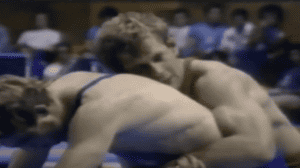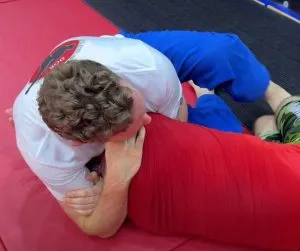Everyone remembers playing with your friends as a kid, wrestling around and getting into a weird hold that seemed magic, one that was at the time inescapable and was a secret weapon that your friends used to dominate all the other kids when wrestling around.
It can be argued that the most natural and perhaps first true wrestling hold any child discovers is the Full Nelson, it is not only a hold for kids to play around with but can be a very effective method of immobilization and even a type of neck crank if placed properly by a strong opponent.

The Full Nelson hold, named after Horation Nelson who was vice Admiral of the British Naval fleet and accredited for defeating Napoleon’s Navy at sea, is originally a Catch Wrestling technique that is also known as the double shoulder lock and double Nelson. There are other types of Nelson holds as well such as the Half Nelson hold, Quarter Nelson hold and Three Quarter Nelson hold which are commonly used in amateur and Olympic wrestling, the Full Nelson being illegal in amateur and Olympic wrestling.
The Nelson Holds are commonly used in amateur and Olympic wrestling both in standing and much more seen in par terre as they are very useful in pinning the opponent as well as setting up dominant positions in a very secure manner.
Wrestlers find the Nelson hold a great controlling hold that can be done standing or on the ground depending on the variation, it is done when you are behind the opponent’s back by by placing your arm or arms (depending on the variation) under the opponent’s arm/s and clasping your hand/s behind the opponents head.
What is the Purpose of the Nelson Hold
There are a few different reasons to use the various Nelson Holds, the first being as a form of positional control as when you controls the opponent’s head, you ultimately control the top of their spine and with your body position near their hips you control 2 out of 3 points of balance (the 3 points of balance being the head, hips and knees) and thus very dominant in controlling the opponent.

The 2nd reason is to punish opponents. All Nelson Holds have the element of pressure being placed on the neck and this is not a comfortable place to be when it’s being done on you. It is very hard to breath and the opponent will need to use quite a bit of energy in order to escape a properly placed Nelson Hold.
The 3rd purpose of a Nelson Hold is to use the opponent’s body against them in creating leverage for a turnover to a pin. We see this at all levels of wrestling competition and time and time again, the simple Nelson Hold, especially the Half-Nelson is commonly used to turnover the opponent from the four quarter position to their back for the pin.
The Different Types of Nelson Holds
There are 4 main types of Nelson holds as explained earlier, they are the Full Nelson, Half Nelson, Quarter Nelson and Three-Quarter Nelson, all of them have a certain grappling scenario and rule set that the move is used for. Here are the types of Nelson Holds and their applications.
The Full Nelson

A true favourite of bouncers, security guards and police when trying to control an attacker, the Full Nelson is applied when behind your opponent with your arms under the opponent’s armpits with your opponent’s arms upwards in the air. Your hands will be behind the opponent’s neck placed together one on top of another and touching the back of the opponent’s neck placing forward pressure on the opponent’s neck while bringing you elbows back thus creating the opponents arms and shoulders to go backwards, this creates a lot of pressure on the neck and can even at times create the sensation of a neck crank. Due to the fact that there is a danger to the vertebrae of the neck, the full nelson is banned from all levels of amateur and Olympic wrestling.
Catch Wrestling does allow the full nelson and generally uses it as an immobilization technique and form of neck crank submission. The Full Nelson can commonly be seen in older hollywood movies and TV shows as well as in WWE wrestling with many famous WWE wrestlers using the move to hurt the opponent, such stars as Bobby Lashley (renaming the Full Nelson as the Hurt Lock) and Chris Masters (renaming the Full Nelson hold as the Master Lock) have used the wrestling hold as one of their signature moves.
The Full Nelson does have a drawback when it comes to combat sports and grappling styles as it does not really allow for any type of finish or pin and is more used to secure the opponent, this is another reason we do not see the move in combat sports such as Brazilian Jiu-jitsu and Mixed Martial Arts.
The Half Nelson

One of the very first moves taught to young aspiring amateur wrestlers, the Half Nelson is a great move for controlling and setting up pins, it is one of the easiest and most commonly used wrestling moves as it is very effective and high percentage.
The Half Nelson is applied in a similar fashion to the Full Nelson but placed when on the ground and not standing up. Generally it is placed when the opponent is in the four quarters position (also known as the turtle position in BJJ) and you are pressuring them from on top and to the side. You simply take one arm and pass it under the opponent’s arm pit and wrap the hand around the back of the opponent’s head. Your 2nd arm (the hand not being used) needs to be locked on the opponent’s wrist thus preventing them from escaping the Half Nelson or posting the Arm to prevent the turnover to the pin.
A great tip for the Half Nelson is to place your hand on the crown of the opponent’s head instead of their neck as this will increase leverage and create more pressure on the opponent.
The Power Nelson
The Half Nelson has a variation that is called the Power Nelson (also known as a Power Half in wrestling) where you take the hand that would be on the wrist of the opponent when doing the original Half Nelson and place it on top of your hand that is on the neck, this creates an immense increase in pressure on the neck of the opponent and generally open up for a pin.
In certain cases it is not possible to get you hand on the opponent’s back of the neck, you use your free hand’s forearm bone as a type of pry bar with the palm of your hand facing toward the ceiling and grabbing that hand with the arm that us under your opponent’s arm to create immense pressure for the turnover.
One issue with the Power Nelson is the fact that the opponent can somewhat post their free hand and thus create some resistance against the wrestling technique.
The Quarter Nelson

A really great version of the Nelson Hold that has a lot of application grappling sports other than wrestling is the Quarter Nelson. Generally the Quarter Nelson does not work in high level wrestling but rather in lower level wrestling as it is effective to place the technique when the opponent shoots with their head down.
The Quarter Nelson is used to secure a pin or move to a much better position and it is employed by placing your hand on your opponent’s neck then placing the other hand under your opponent’s arm at the armpit area, locking the other arm by grabbing the wrist and placing pressure.
The Three-Quarter Nelson
The Three Quarter Nelson has become rather a famous wrestling position lately and is starting to become utilized more and more in Brazilian Jiu-jitsu and Submission Grappling as it is very close to the D’Arce Choke.

Performing the Three-Quarter Nelson is similar to the Half Nelson but with taking the free hand and passing it underneath the opponent on the same side. Due to the fact that one of the hands is passed far side above the neck and grasping the other hand’s wrist around the neck with a palm to palm grip is the reason the Three Quarter Nelson position is so familiar to submission grapplers as it essentially is the exact same setup for the D’Arce Choke, the difference is that in amateur and Olympic wrestling, chokes are illegal so the move is to setup a pin. It should be noted that the Three Quarter Nelson is a much higher percentage move than the Half Nelson when it is done properly.
One of the most important details of the Three Quarter Nelson is to trap your opponent’s near side leg with your own leg so they cannot spin out of the hold.
How to Counter The Full Nelson
There are many different ways to counter the Full Nelson but the best way is the Dean Lister Method of escaping the Full Nelson. Dean Lister who is a master grappler, ADCC Champion, UFC fighter and BJJ Blackbelt has come up with a truly great way to escape a Full Nelson.
Dean teaches to place the backside of one hand on your forehead and take the other hand to grasp that hand in an S grip. Once this grip is achieved, you press against your own forehead while pushing back with your neck and try to bring your inner side of your elbow towards the center of your chest in a fly motion. This creates an incredible amount of leverage and if done correctly will get you out of a properly placed Full Nelson.
How to Counter The Half Nelson
The Half Nelson is not a great place to be when in a wrestling match and many inexperienced athletes make the mistake of turning into their opponent when trying to counter the Half Nelson.
There are so many different Half Nelson counters but the one that we love at Grapplezilla is to
first look away from the opponent and raise your head ever so slightly, next you want to grab the opponents fingers that are on the back of your head with the same side hand as the hand you are grabbing in order to peel the hand away from your neck and place the hand on the ground with your hand on top. Now post your free hand on the mat and raise your body up so you can knee slice out of the position.
How to Counter The Quarter Nelson
The first way to counter a Quarter Nelson is at the moment your opponent goes for the Quarter Nelson, you keep your head strong and drive to grab the opponent’s legs as if you were shooting for a single leg.
Should your opponent get the Quarter Nelson position you simply place a Half Nelson on yourself (which will have your hands on top of the opponent’s hands) place pressure down against your own neck and upwards at the same time as backing your body out and away from the opponent.
How to Counter The Three Quarter Nelson
Countering the Three Quarter Nelson can be broken down into 2 different scenarios, one where the 3 Quarter Nelson is in process of being applied and 1 where the ¾ Nelson has been applied.
In the wrestling scenario that your opponent is in the process of placing you in the Three Quarter Nelson all you need to do is to tuck your head a bit down and spin in towards the side your opponent is on and continue forward to attack their legs while performing a spin out.
If you should find yourself in a Three Quarter Nelson you can hook the same side arm’s elbow, tuck your head in the space between your bodies and perform the same side sit out. In Submission Grappling and Catch Wrestling, you can continue on the arm for a finishing hold which is a Kimura or Chicken wing depending on the grappling style you are practicing.
In Conclusion
The Full Nelson, Half Nelson, Quarter Nelson and Three Quarter Nelson are great grappling techniques that can be used at all levels of competition, they are versatile and easy to perform. Regardless if you are an aspiring Olympic wrestler, a BJJ enthusiast, a No-Gi Submission grappler or an MMA fighter, knowing the Nelson Holds is only going to be advantageous to you controlling your opponent and getting closer to victory.




